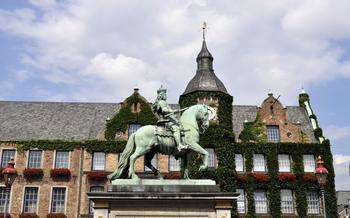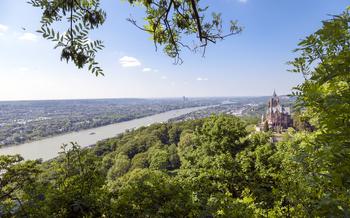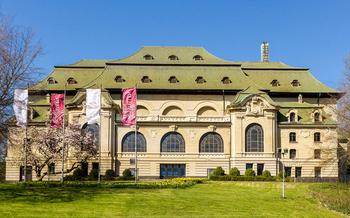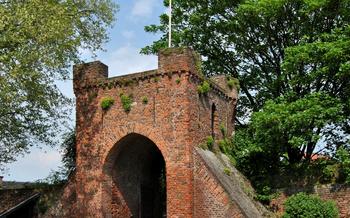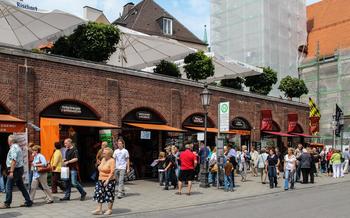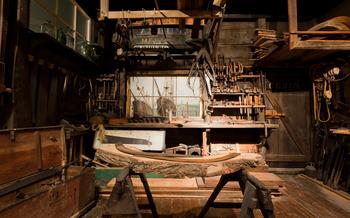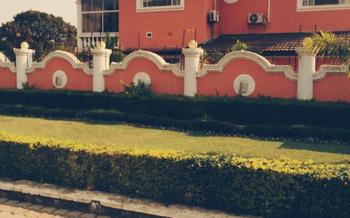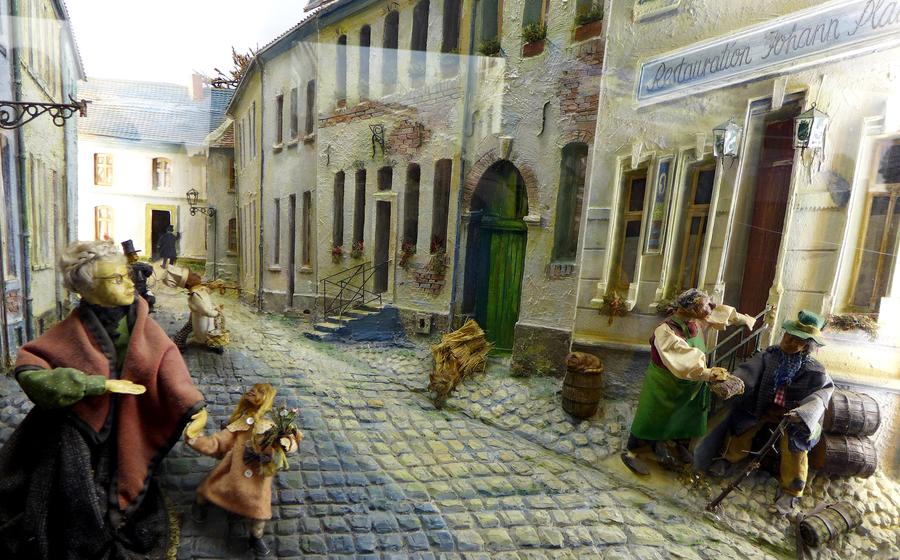
Haus der Seidenkultur (House of Silk Culture)
- Krefeld
- History: Unveiling the rich textile heritage of Krefeld and the significance of the Haus der Seidenkultur
- Architecture: Exploring the architectural features and design elements of the museum building
- Exhibitions: Providing an overview of the various exhibits and displays showcasing silk production, fashion, and cultural influences
- Interactive Experiences: Highlighting the interactive elements and hands-on activities that enhance visitor engagement
- The Silk Route: Tracing the Path of a Precious Fabric
- The Art of Silk Weaving: A Tapestry of Skill and Creativity
- Fashion and Design: Silk's Enduring Influence
- Textile Innovations: Pushing the Boundaries of Silk
- Interactive Exhibits: Engaging with Silk's Story
- Exhibitions Throughout the Year: A Dynamic Showcase
- Planning Your Visit: Essential Information
- Local Cuisine and Dining Options
- Exploring Krefeld's Textile Heritage Beyond the Museum
- Traveling to Krefeld: A Seamless Journey
- Experiencing Krefeld's Cultural Scene
- Insider Tip: Unveiling Hidden Gems
Krefeld
History: Unveiling the rich textile heritage of Krefeld and the significance of the Haus der Seidenkultur
Nestled in the heart of Krefeld, Germany, the Haus der Seidenkultur (House of Silk Culture) stands as a testament to the city's rich textile heritage. Once a thriving center of silk production, Krefeld earned a reputation for its exquisite silk fabrics, renowned for their intricate designs and luxurious quality. The Haus der Seidenkultur, housed in a beautifully preserved 19th-century building, invites visitors to embark on a journey through the captivating world of silk, tracing its history, cultural influences, and enduring impact on fashion and design.
Architecture: Exploring the architectural features and design elements of the museum building
The Haus der Seidenkultur's architectural design mirrors the elegance and sophistication of the silk trade it represents. The building's stately façade, adorned with intricate carvings and decorative elements, hints at the treasures within. Inside, visitors are greeted by a grand entrance hall, featuring a sweeping staircase that leads to the museum's various exhibits. The spacious galleries are designed to showcase the beauty and diversity of silk, with natural light flooding through large windows, illuminating the vibrant colors and intricate patterns of the fabrics on display.
Exhibitions: Providing an overview of the various exhibits and displays showcasing silk production, fashion, and cultural influences
The Haus der Seidenkultur's exhibitions offer a comprehensive exploration of the world of silk. Visitors can learn about the history of silk production, from the cultivation of mulberry trees to the intricate processes of spinning, weaving, and dyeing. Interactive displays allow visitors to experience the sights, sounds, and smells of a traditional silk workshop, while historical garments and accessories showcase the evolution of silk fashion through the ages. The museum also delves into the cultural influences that shaped Krefeld's silk industry, highlighting the contributions of artisans, merchants, and designers from around the world.
Interactive Experiences: Highlighting the interactive elements and hands-on activities that enhance visitor engagement
The Haus der Seidenkultur recognizes the power of interactive experiences to engage visitors and bring the world of silk to life. Throughout the museum, visitors are invited to touch, feel, and experiment with different types of silk fabrics, gaining a deeper appreciation for their unique textures and qualities. Hands-on activities, such as weaving on a miniature loom or designing their own silk patterns, provide a fun and educational way for visitors to learn about the artistry and skill involved in silk production.
The Silk Route: Tracing the Path of a Precious Fabric
The ancient Silk Road, a network of trade routes that spanned from China to the Mediterranean, played a pivotal role in the global exchange of goods and ideas. Along this legendary route, silk, a luxurious and highly sought-after fabric, was transported from its origins in China to various corners of the world. This precious commodity not only facilitated trade but also fostered cultural exchange and understanding among diverse civilizations.
Krefeld's Role in the Silk Trade Network
Krefeld, a city in western Germany, emerged as a prominent hub within the silk trade network. During the 18th and 19th centuries, Krefeld's silk industry flourished, earning the city a reputation as a center of silk production and innovation. The city's favorable location, skilled workforce, and access to raw materials contributed to its success in the silk trade.
Silk Production Techniques
The production of silk involves a meticulous and intricate process. From the cultivation of mulberry trees, which provide food for silkworms, to the delicate extraction of silk fibers from their cocoons, each step requires precision and expertise. Traditional methods of silk cultivation, spinning, and weaving have been passed down through generations, ensuring the preservation of this ancient craft.
Cultural Influences on Krefeld's Silk Industry
The silk industry in Krefeld was influenced by a multitude of cultural factors. Interactions with countries along the Silk Road, such as China, India, and Persia, brought new ideas and techniques to the city. These influences can be seen in the diverse designs and patterns that adorned Krefeld's silk fabrics, reflecting a rich tapestry of cultural exchange.
The Art of Silk Weaving: A Tapestry of Skill and Creativity
Krefeld's silk industry relied on the expertise of skilled weavers who transformed raw silk threads into intricate textiles. The museum delves into the traditional techniques and methods involved in silk weaving, showcasing the painstaking process from cocoon to cloth. Visitors can observe demonstrations of traditional weaving on hand-operated looms, gaining an appreciation for the precision and artistry required.
The invention of the Jacquard loom in the 19th century revolutionized silk weaving, allowing for complex patterns and designs to be woven with greater efficiency. The museum houses a collection of historic Jacquard looms, providing insights into the technological advancements that shaped the silk industry. Visitors can learn about the role of master weavers, whose skills and creativity were instrumental in creating the exquisite silk fabrics that made Krefeld famous worldwide.
The Haus der Seidenkultur also explores contemporary interpretations and innovations in silk weaving. It features works by contemporary weavers who push the boundaries of the craft, experimenting with new techniques, materials, and designs. These modern creations demonstrate the continued relevance and versatility of silk in the world of textiles and fashion.
Fashion and Design: Silk's Enduring Influence
Silk has left an indelible mark on the world of fashion and design, captivating hearts and imaginations for centuries. The Haus der Seidenkultur showcases historical garments and accessories crafted from this luxurious fabric, highlighting their significance and evolution throughout the ages. Visitors can marvel at intricate clothing, exquisite embroidery, and delicate lace, each piece a testament to the skill and artistry of past generations.
Contemporary designers continue to embrace silk's allure, incorporating it into their creations with a modern twist. The museum features works by renowned designers who push the boundaries of fashion, using silk to create innovative and eye-catching garments. From haute couture gowns to avant-garde streetwear, silk's versatility shines through, proving its timeless appeal.
Haute couture and luxury brands have long recognized silk's exceptional qualities, using it to create exclusive and opulent pieces. Whether it's a flowing evening gown, a tailored suit, or a delicate lingerie set, silk adds an air of sophistication and elegance to any ensemble. The museum's collection includes examples of these luxurious creations, providing a glimpse into the world of high-end fashion.
Beyond clothing, silk finds its way into various accessories and home décor items, demonstrating its versatility and adaptability. Scarves, shawls, ties, and handbags made from silk exude a refined and polished look. In the home, silk cushions, curtains, and tapestries add a touch of warmth and luxury to any room. The Haus der Seidenkultur showcases these diverse applications, inspiring visitors to explore the many ways silk can enhance their personal style and living spaces.
Textile Innovations: Pushing the Boundaries of Silk
Technological Advancements: The Haus der Seidenkultur delves into the realm of cutting-edge technologies that are revolutionizing silk production and design. Visitors can explore interactive exhibits that showcase innovative techniques such as 3D printing, digital weaving, and computer-aided design, which are transforming the traditional silk industry. These exhibits highlight how technology is pushing the boundaries of silk's possibilities, creating new textures, patterns, and applications that were once unimaginable.
Sustainable Practices: The museum also sheds light on sustainable approaches to silk cultivation and manufacturing. Visitors can learn about organic sericulture, which focuses on environmentally friendly practices such as natural pest control and the use of organic fertilizers. The exhibits emphasize the importance of reducing the ecological footprint of silk production, promoting fair trade practices, and ensuring the well-being of silkworms.
Performance Textiles: The Haus der Seidenkultur introduces visitors to the world of performance textiles, where silk is combined with advanced materials to create fabrics with exceptional properties. These textiles are used in a wide range of applications, from sports apparel and medical devices to protective clothing and aerospace components. Visitors can explore exhibits that showcase the unique properties of silk-based performance textiles, such as their strength, elasticity, breathability, and moisture-wicking abilities.
Future Trends: The museum concludes its exploration of textile innovations by discussing potential future directions and advancements in silk-based textiles. Visitors can learn about ongoing research and development in areas such as biomimicry, nanotechnology, and smart textiles. The exhibits provide a glimpse into the future of silk, where it is poised to play an even more significant role in various industries, from fashion and healthcare to high-performance materials.
Interactive Exhibits: Engaging with Silk's Story
The Haus der Seidenkultur offers a range of interactive exhibits that allow visitors to delve deeper into the world of silk and experience its production firsthand. These exhibits are designed to engage visitors of all ages and provide a hands-on learning experience.
Experience Silk's Texture: Feel the smoothness of raw silk fibers, the delicate sheen of woven fabric, and the intricate textures of different silk weaves. Interactive displays allow you to touch and compare different types of silk, gaining an appreciation for their unique qualities.
Witness Silkworms at Work: Observe live silkworms as they spin their cocoons, a mesmerizing process that forms the foundation of silk production. Learn about the life cycle of these remarkable creatures and their vital role in the silk industry.
Weave Your Own Creation: Try your hand at silk weaving using small looms and colorful threads. Create a unique souvenir or simply experiment with different patterns and techniques, gaining insights into the skill and artistry involved in this traditional craft.
Virtual Silk Journey: Immerse yourself in the history and culture of silk through interactive virtual reality experiences. Explore the ancient Silk Road, visit silk markets around the world, and learn about the diverse cultural influences that have shaped silk's journey.
Interactive Multimedia Displays: Multimedia exhibits provide in-depth information and storytelling, allowing visitors to explore specific aspects of silk production, fashion, and history. Touchscreens, videos, and audio guides offer a wealth of knowledge and insights.
Workshops and Demonstrations: Throughout the year, the museum hosts workshops and demonstrations led by skilled silk artisans. Learn from the experts as they demonstrate traditional weaving techniques, share their knowledge of silk dyeing and finishing, and answer your questions.
Exhibitions Throughout the Year: A Dynamic Showcase
The Haus der Seidenkultur is not just a static museum; it is a dynamic space that constantly evolves and offers new perspectives on silk and textile arts. Temporary exhibits, special events, workshops, and lectures bring fresh ideas and themes to the museum, ensuring that there is always something new to discover.
Temporary Exhibits: Rotating temporary exhibits showcase a diverse range of topics related to silk and textiles. These exhibits may focus on historical periods, specific regions, or contemporary trends. The museum collaborates with scholars, artists, and designers to present innovative and thought-provoking exhibitions that push the boundaries of textile art.
Special Events: Throughout the year, the Haus der Seidenkultur hosts special events, workshops, and lectures that delve deeper into the world of silk. These events provide opportunities for visitors to engage with experts, learn new skills, and gain a deeper understanding of the textile industry. From hands-on weaving workshops to talks by renowned textile designers, there is something for everyone at these special events.
Seasonal Displays: The museum also adapts its exhibits to reflect different seasons and occasions. During the holiday season, the museum may showcase special displays featuring festive silk decorations or ornaments. In the spring, visitors can admire exhibits that celebrate the vibrant colors and patterns of nature. These seasonal displays add a dynamic touch to the museum and keep visitors coming back for more.
Online Exhibitions: For those unable to visit the museum in person, the Haus der Seidenkultur offers a selection of virtual exhibitions online. These online exhibitions provide a glimpse into the museum's collection and allow visitors to explore the history and significance of silk from the comfort of their own homes.
Planning Your Visit: Essential Information
Visiting the Haus der Seidenkultur is a rewarding experience for anyone interested in textiles, fashion, or cultural history. To ensure a smooth and enjoyable visit, here are some essential details to keep in mind:
Location and Directions:
The Haus der Seidenkultur is conveniently located in the heart of Krefeld, at Luisenstraße It is easily accessible by public transportation, with several bus and tram lines stopping nearby. For those arriving by car, there are ample parking options in the vicinity.
Operating Hours:
The museum is open from Tuesday to Sunday, from 11 am to 5 pm. On select public holidays, the museum may have adjusted hours or be closed. It is advisable to check the museum's website or call ahead to confirm operating hours before your visit.
Admission Fees:
Admission to the Haus der Seidenkultur is charged at a reasonable fee. Adults pay €6, while children and students with valid identification pay a reduced fee of €Group discounts and family tickets are also available.
Accessibility:
The Haus der Seidenkultur is committed to providing an inclusive and accessible environment for all visitors. The museum is wheelchair accessible, with ramps and elevators throughout the building. Visitors with disabilities can also borrow wheelchairs or request assistance from museum staff.
Local Cuisine and Dining Options
Krefeld offers a diverse culinary scene that caters to every palate. Silk-inspired dishes can be found at several local restaurants, adding a unique twist to your dining experience. Indulge in culinary delights that incorporate silk as an ingredient or are inspired by the silk production process.
Beyond silk-themed cuisine, Krefeld boasts a range of dining options, from traditional German fare to international flavors. Whether you prefer hearty schnitzel or exotic Asian cuisine, there's something for everyone.
For a quick bite or a relaxing break, visit the café or tearoom within the Haus der Seidenkultur. Savor a cup of coffee or tea paired with freshly baked pastries or light snacks while immersing yourself in the museum's ambiance.
If you prefer a picnic lunch, head to one of the nearby parks or gardens. Spread out a blanket and enjoy a leisurely meal surrounded by nature's beauty. Several parks, such as the Stadtpark Uerdingen or the Botanischer Garten Krefeld, offer picturesque settings for an al fresco dining experience.
Exploring Krefeld's Textile Heritage Beyond the Museum
Krefeld's rich textile history extends beyond the walls of the Haus der Seidenkultur. Visitors can embark on a journey through the city's textile heritage by exploring the historic silk district, where preserved buildings and landmarks tell the story of Krefeld's past as a prominent silk producer. Other textile museums in the city, such as the Deutsches Textilmuseum or the Textilmuseum Bocholt, offer further insights into the art of weaving and the evolution of textile production. Throughout the year, Krefeld hosts textile-themed festivals and events that celebrate the city's textile heritage and showcase the work of local artisans. Visitors can also find a variety of shops and boutiques specializing in textiles, fabrics, and clothing, offering a unique opportunity to purchase high-quality textile products and support local businesses.
Traveling to Krefeld: A Seamless Journey
Krefeld boasts excellent transportation connections, making it effortlessly accessible from major cities in Germany and beyond. The city is well-served by its central train station, which offers direct connections to Düsseldorf, Cologne, and other regional hubs. For those arriving by air, Düsseldorf International Airport (DUS) is the nearest major airport, located just a short train ride away.
Accommodation options in Krefeld cater to a range of budgets and preferences. From budget-friendly hostels and guesthouses to comfortable hotels and luxurious suites, there's something to suit every traveler. To ensure a hassle-free stay, it's advisable to book accommodation in advance, especially during peak tourist seasons.
The local tourist information office, located in the city center, is an invaluable resource for visitors. They provide comprehensive travel information, maps, and recommendations to help you plan your stay. The staff is multilingual and can assist with any inquiries or bookings you may have.
For international visitors, language barriers may be a minor inconvenience. However, most locals in Krefeld have a good command of English, and many tourist attractions and businesses offer multilingual services. The official currency in Germany is the Euro, and visitors can easily exchange their currency at banks, exchange bureaus, or ATMs located throughout the city.
Experiencing Krefeld's Cultural Scene
Beyond its rich textile heritage, Krefeld offers a vibrant cultural scene that caters to diverse interests. The city boasts a renowned theater and arts scene, with the Theater Krefeld Mönchengladbach and the Krefelder Kunstmuseen taking center stage. These venues showcase a range of performances, from classical theater to contemporary dance, and host exhibitions featuring works by renowned artists.
For those seeking tranquility and natural beauty, Krefeld's parks and gardens provide a welcome respite. The Stadtwaldpark invites visitors to stroll through its lush greenery, while the Botanischer Garten Krefeld offers a diverse array of plant life from around the world.
Krefeld's shopping districts offer a mix of high-street brands and independent boutiques, catering to every taste and budget. The Ostwall and Königstraße are particularly popular for their diverse selection of shops. As the sun sets, the city's nightlife comes alive, with a variety of bars, clubs, and restaurants offering entertainment well into the night.
Throughout the year, Krefeld hosts a range of major events and festivals, showcasing its cultural diversity and vibrant atmosphere. The Krefelder Karneval, with its colorful parades and festivities, is a must-see for visitors during the winter months. The Krefelder Stadtfest, held in the summer, transforms the city center into a lively festival ground with music, food, and entertainment for all ages.
Insider Tip: Unveiling Hidden Gems
Beyond the museum's walls, Krefeld offers a treasure trove of hidden gems for textile enthusiasts. Discover secret silk workshops where you can learn traditional weaving techniques from master artisans, immerse yourself in the city's textile heritage on guided tours that take you to lesser-known factories and production facilities, or unearth unique silk treasures at vintage textile markets and flea markets. For those seeking a deeper dive into Krefeld's textile history, the city's textile libraries and archives house a wealth of knowledge and resources, waiting to be explored.

